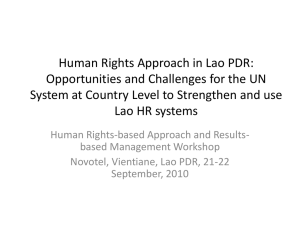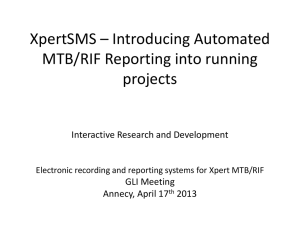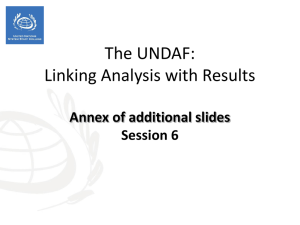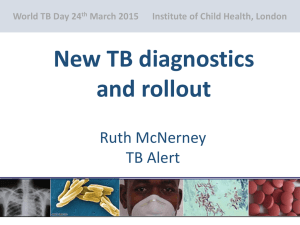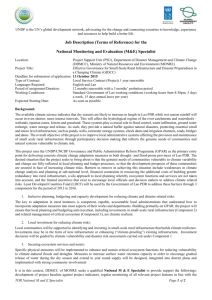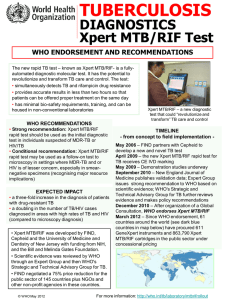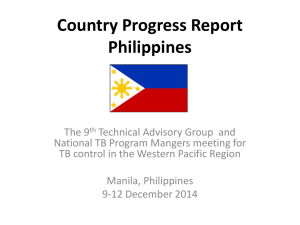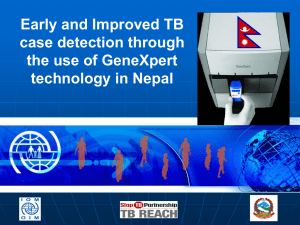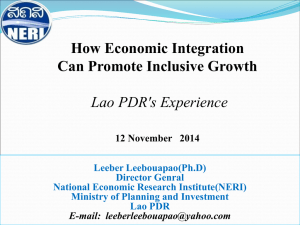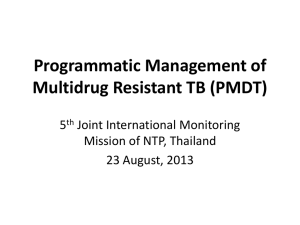Country Progress Report - WHO Western Pacific Region
advertisement
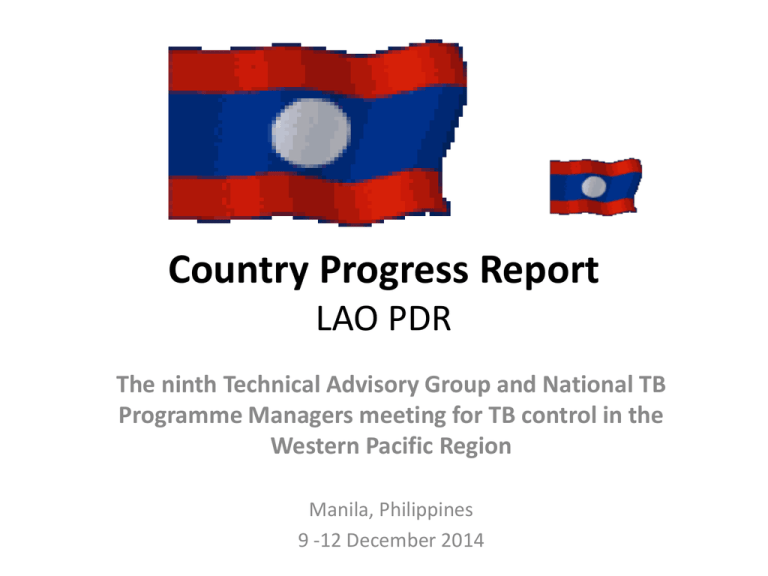
Country Progress Report LAO PDR The ninth Technical Advisory Group and National TB Programme Managers meeting for TB control in the Western Pacific Region Manila, Philippines 9 -12 December 2014 TB Epidemiology WHO Global Tuberculosis Report 2014 2 Major successes • DOTS started in 1995 with WHO and Damien Foundation Belgium • In 5 central, 17 provincial, 142 districts hospitals and 903 health centres (95%) and 175 private clinics and pharmacies (PSI) • 4124 notified TB cases (2013) and treatment success rate 90% (2012) • First TB prevalence survey in 2010 and first external TB review in 2013 • Culture started in 2010 and DST in 2014 • GeneXpert in 2 central hospitals and 1 provincial hospital (Savannakhet) • 76% TB patients have HIV test result (Q3 2014) • PMDT started in 2011: 25 MDR-TB patients on 9 month regimen (July 2013-Nov 2014) • The NSP 2015-2019 is based on prevalence survey and TB review findings and recommendation to increase TB case detection 3 1. Census 2. Interview TB prevalence survey 3. Chest X-Ray 3. Specimen collection 4 Major challenges • Stagnation in TB detection (31% CDR all forms, 2013) • Low identification and referral of presumptive TB in some provinces/districts • Low referral by OPD, IPD, MCH etc. • Child TB is under diagnosed • TB HIV collaboration is still limited • MDR is under diagnosed and often late • Low sensitivity of direct microscopy • Lack of information of the population on TB • Insufficient involvement of community • Managerial constraints (funding, infrastructure, procurement, administrative procedures) 5 Case detection Notification rates of tuberculosis in Lao PDR, 1995-2013 stagnation 70.00 Rate per 100,000 60.00 50.00 All new and relapse TB New S+ PTB 40.00 30.00 20.00 10.00 New S- PTB Extra pulmonary Relapse PTB 0.00 Source: NTC 6 National TB Strategic Plan 2015-2019 • Aligned with National Health Sector Plan • Budgeted • Funded mostly by Global Fund (NFM request for 2015-2017) and other partners (WHO, DFB, USAID): • LAO PDR NTP will be member of the Mekong Basin Disease Surveillance Vision: zero deaths, disease and suffering due to TB Goal: To reduce TB burden and to reach the targets of WHO Post-2015 Global Tuberculosis Strategy (adopted by 67th World Health Assembly 2014 on 19 May 2014) Specific target: Increase TB case detection rate (CDR) from 31% in 2013 to 70% in 2019 Objectives: 1. Integrated patient centred TB care and prevention 2. Strengthening TB-HIV collaborative activities 3. Managing drug resistant tuberculosis (PMDT) 4. Improved management 7 TB detection in Lao PDR, forecast 2015-2019 2013 2014 2015 2016 2017 2018 2019 Country Population 6,608 6,726 6,841 6,950 7,060 7,160 7,268 (X1000) No. sputum smear 35,623 38,000 40,000 42,500 45,000 47,500 50,000 examination (rate per 1000) 5.4 5.6 5.8 6.1 6.4 6.6 6.9 New and relapse B+ (SSM and Xpert 3,197 3984 4246 4793 5358 5952 6545 MTB RIF*) Clinically diagnosed 541 602 700 800 900 1000 1000 Pulmonary TB Extra pulmonary 392 450 500 550 600 600 600 Total new and 4,130 5036 5446 6143 6858 7552 8145 relapse Estimated incidence 13,080 12,836 12,584 12,325 12,071 11,816 11,559 Case Detection Rate (CDR) all TB 32% 36% 43% 50% 57% 64% 70% cases Source NTC: 8 *if 15% Xpert positive among new presumptive TB Laboratory strengthening •LED: not significant advantage compared to ZN in Lao context of low work load • Xpert MTB/RIF: 30% yield compared to microscopy (as a first test, NRL April-Nov 2014) • GeneXpert scaling-up: cumulative 10 in 2014 (being procured), 15 in 2015, 20 in 2016 • EQA microscopy since 2004, • QA Culture and DST with KIT as SRL •Laboratory information management system •TA partners: WHO, Stop TB partnership, KIT, Merieux Foundation 9 Scaling-up Xpert MTB/RIF testing in Lao PDR 10 Reach the unreached: intensive case finding • Engaging all health providers in public (OPDs, IPDs, MCH, ANC etc. and private sector) at all levels of the PHC • ICF among house hold TB contacts including children, PLWH, prisoners, mine workers, mobile population, factories, patient with diabetes and other co-morbidities, • ACF mobile camps in high prevalence areas (with CXR and GeneXpert) • Diagnosis and treatment of child-TB • Identify and refer all presumptive TB patients to the TB unit or to the TB laboratory • Support health centres (training, supervision, budget for transportation of specimens) • Advocate to local authority, chiefs of villages, village health committees to involve in TB control activities • Use NGOs/CBOs (LYU, LOPHA, MAAP, PEDA, PSI) 11 Patient centred care: involvement of patients and civil society • All stakeholders, public sector, donors, partners, NGOs/CBOs, key affected population and patients representatives provided their input in situation analysis, NSP elaboration and country dialogue (workshops) • TB technical working group (TWG) includes NGOs/CBOs and partners • NGOs/CBOs conduct joint need assessment surveys with local authorities to identify at risk population and explore gaps and barriers in accessing TB services • NGOs/CBOs mobilize village health committees, chiefs of villages and villagers for TB case detection and sending patients/specimens in relation with the health centres and to participate in ACF campaigns • NTP supports specimen transportation from health centres to TB laboratory 12 TB/VIH Collaboration with CHAS (planning, training and supervision) Rapid HIV testing for all TB patients (77% in 2014, target 100%) Coordination with CHAS for CPT and early ART among all TB-HIV patients «3 Is » among the PLWH: Intensive case finding, infection control and IPT TB patients with an HIV test result, Lao PDR 2001-2014 5000 No. of TB patients • • • • 4000 Total new TB cases (all 3392 forms) 2367 Total HIV tested 2088 1869 3000 2000 1220 1233 1000 0 78 59 497 533 177 280 265 400 *2014: projection of 3Q, NTC data 13 PMDT Achieved Target Presumptive MDR-TB patients examined by Xpert MTB/RIF or culture/DST (retreatment) 60% 100% RR/MDR-TB patients enrolled 90% 100% 25 35 in 2014, 40 in 2015, 45 in 2016, 50 in 2017 In preparation with KIT 2015 100% 100% 9 months MDR treatment: 25 MDR-TB patients under treatment in Dec 2014 Surveillance (DRS in 2015) MDR-TB patients support for transportation, food, examinations Follow-up and care of adverse drugs events (report to FDD) Report severe ADE to FDD Cohort event monitoring (2015) Training of all physicians on PMDT (including diagnosis, treatment and infection control) Central level Train all provinces by 2015 Infection Control (administrative, environment, personal protection) Training of limited number of staff Train health staff at all levels on IC Data management E-RR under development Electronic R/R in 2015 14 Surveillance • Quality of surveillance system: EQA microscopy established since 2004 • QA culture and DST with KIT • DRS to be conducted in 2015 • New case definition rolled out in new national TB guidelines 3 rd edition (2014) • e-R&R: under development for MDR-TB • Analysis and usage of data at national and sub-national levels: briefing and debriefing meeting of NTP supervisors • LAO PDR NTP will become member of the Mekong Basin Disease Surveillance (cross-border information and collaboration on TB control) 15 Policies and supportive systems • TB care financing and social protection: – social protection is limited to only 10-15% of the population • Strengthening notification mechanism: – Training all physicians and nurses in TB wards, OPD, IPD in public and private hospitals, in health centres, village health volunteers (VHV) and village health workers (VHW), private clinics and pharmacists – paper based RR system to be upgraded to electronic RR • Drug regulations: – No change since drug regulation meeting in March 2014 16 Management • • • • Supervising all levels (central, province, district hospitals and health centre) and visit TB patients Improving communication, reporting and feed back (web based R/R) Train staff of all levels on administration, finances and reporting Ensure procurement, maintenance, logistic and storage 17 Partners 18 Thank you 19
